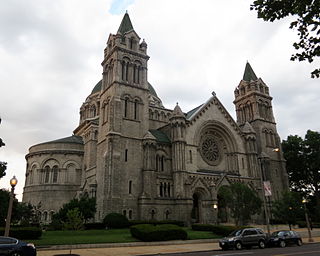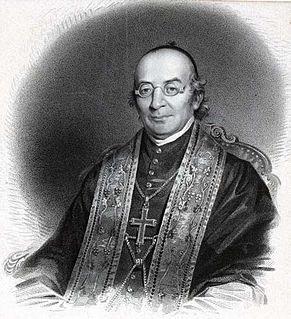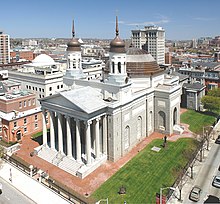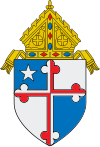
The Metropolitan Archdiocese of Baltimore is the premier see of the Roman Catholic Church in the United States. The archdiocese comprises the City of Baltimore and 9 of Maryland's 23 counties in the central and western portions of the state: Allegany, Anne Arundel, Baltimore, Carroll, Frederick, Garrett, Harford, Howard, and Washington. The archdiocese is the metropolitan see of the larger regional Ecclesiastical Province of Baltimore. The Archdiocese of Washington was originally part of the Archdiocese of Baltimore.

The Cathedral Basilica of Saint Louis, also known as the Saint Louis Cathedral, is a cathedral of the Roman Catholic Church located in the Central West End neighborhood of St. Louis, Missouri. Completed in 1914, it is the mother church of the Archdiocese of St. Louis and the seat of its archbishop, currently Mitchell T. Rozanski. The cathedral is named for Saint Louis and was designated a basilica by Pope John Paul II in 1997.

The Basilica of the National Shrine of the Immaculate Conception is a large Catholic minor basilica and national shrine located in Washington, D.C., United States, on 400 Michigan Ave NE, Washington, DC 20017, near the Catholic University of America.

The Cathedral of Saint Paul is a Roman Catholic cathedral in the city of St. Paul, Minnesota. It is the Cathedral of the Archdiocese of Saint Paul and Minneapolis; the Co-Cathedral is the Basilica of St. Mary in Minneapolis. One of the most distinctive cathedrals in the United States, it sits on Cathedral Hill overlooking downtown St. Paul and features a distinctive copper-clad dome. It is dedicated to Paul the Apostle, who is also the namesake of the City of St. Paul. The current building opened in 1915 as the fourth cathedral of the archdiocese to bear this name. On March 25, 2009, it was designated as the National Shrine of the Apostle Paul by the United States Conference of Catholic Bishops and the Vatican. It is the third-largest Catholic cathedral and sixth-largest church in the United States.

William Henry Keeler was an American cardinal of the Catholic Church. He served as Archbishop of Baltimore, Maryland, from 1989 to 2007 and was elevated to the College of Cardinals in 1994. He previously served as Auxiliary Bishop and Bishop of the Diocese of Harrisburg. Keeler was President of the United States Conference of Catholic Bishops from 1992 to 1995.

The Basilica of Saint Mary is a Roman Catholic minor basilica located on its own city block along Hennepin Avenue between 16th & 17th Streets in downtown Minneapolis, Minnesota. It was the first basilica established in the United States. The Basilica of Saint Mary is the co-cathedral of the Roman Catholic Archdiocese of Saint Paul and Minneapolis.

The Roman Catholic Archdiocese of Washington is an archdiocese of the Roman Catholic Church in the United States. It comprises the District of Columbia and Calvert, Charles, Montgomery, Prince George's and Saint Mary's counties in the state of Maryland. It was originally part of the Archdiocese of Baltimore.

The Cathedral of the Assumption is a cathedral and mother church of the Roman Catholic Archdiocese of Louisville in Louisville, Kentucky. Joseph E. Kurtz, D.D., the fourth Archbishop of Louisville, is in residence at the Cathedral. The Very Rev. Martin A. Linebach, Vicar General for the Archdiocese of Louisville, also serves as Rector.

The Cathedral of Mary Our Queen is a cathedral of the Roman Catholic Church located at 5200 North Charles Street, in northern Baltimore, Maryland, USA. The structure, remarkable in size, was completed in 1959.

The Cathedral Basilica of Saints Peter and Paul, head church of the Roman Catholic Archdiocese of Philadelphia, is located at 18th Street and the Benjamin Franklin Parkway, on the east side of Logan Square in Philadelphia. It was built between 1846 and 1864, and was designed by Napoleon LeBrun, from original plans by the Reverend Mariano Muller and the Reverend John B. Tornatore, with the dome and Palladian facade, designed by John Notman, added after 1850. The interior was largely decorated by Constantino Brumidi.
William Donald Borders was an American prelate of the Roman Catholic Church. He was the 13th Archbishop of Baltimore from 1974 to 1989, having previously served as the first Bishop of Orlando from 1968 to 1974.

Ambrose Maréchal, P.S.S. was an American Sulpician and prelate of the Roman Catholic Church who served as the third Archbishop of the Archdiocese of Baltimore in Maryland. He dedicated the Basilica of the National Shrine of the Assumption of the Blessed Virgin Mary, the oldest cathedral in the United States, in Baltimore in 1821.

St. Peter the Apostle Church was a Roman Catholic church located within the Archdiocese of Baltimore in Baltimore, Maryland. Constructed at the northwest corner of Hollins and South Poppleton Streets and, it was often referred to as "The Mother Church of West Baltimore."

The First Unitarian Church is a historic church and congregation at 12 West Franklin Street in Baltimore, Maryland. Dedicated in 1818, it was the first building erected for Unitarians in the United States. The church is a domed cube with a stucco exterior. The church, originally called the "First Independent Church of Baltimore", is the oldest building continuously used by a Unitarian congregation. The name was changed in 1935 to "The First Unitarian Church of Baltimore " following the merger with the former Second Universalist Church at East Lanvale Street and Guilford Avenue in midtown Baltimore. The American Unitarian Association and the Universalist Church of America (established 1866) representing the two strains of Unitarian Universalism beliefs and philosophies merged as a national denomination named the Unitarian Universalist Association in May 1961.

St. Mary's Seminary Chapel, located at 600 North Paca Street in the Seton Hill neighborhood of Baltimore, Maryland, is the oldest Neo-Gothic style church in the United States. It was built from 1806 through 1808 by French architect J. Maximilian M. Godefroy for the French Sulpician priests of St. Mary's Seminary. Godefroy claimed that his design was the first Gothic building in America.

John Carroll was a prelate of the Roman Catholic Church who served as the first bishop and archbishop in the United States. He served as the ordinary of the first diocese and later Archdiocese of Baltimore, in Maryland, which at first encompassed all of the United States and later after division as the eastern half of the new nation.
The Catholic Review is Maryland's largest paid weekly newspaper, distributed by mail. The Review covers national and international news of interest to Catholics and serves as the newspaper of record for the archdiocese of Baltimore. The Review is the successor to the original diocesan newspaper The Catholic Mirror which was published until 1908. After an interval of five and a half years, under James Cardinal Gibbons, then Archbishop of Baltimore, the Baltimore Catholic Review was initiated and later renamed with the shorter title of The Catholic Review.
Baltimore College was a secular college in the city of Baltimore, Maryland, founded in 1804. It was a private non-sectarian institution, although the president of its board of directors when it was formed also happened to be the Roman Catholic bishop of Baltimore, John Carroll, first ordained Roman Catholic bishop and archbishop in America in 1790.
St. Peter's Church, also known as St. Peter's Pro-Cathedral, was a historic church in Baltimore, Maryland that served as the first Catholic pro-cathedral in the United States; first built in 1770, the church became the pro-cathedral of the Diocese of Baltimore when the diocese was created in 1789, and the seat of Archbishop John Carroll, the first Catholic bishop in the United States. The church was situated on the 300 block of Charles Street at Saratoga Street. The first resident pastor of the church was Fr. Charles Sewell of St. Mary's County. St. Peter's served all Catholics within the city of Baltimore who could travel to it, which was an anomaly among Catholic churches in the United States before 1884, which were largely defined by the nationality of their parishioners.
























